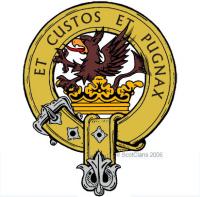
Clan Marjoribanks
Princess Marjorie, the only daughter of King Robert the Bruce, married Walter Stewart, High Steward of Scotland, in 1316. She was thus the mother of the first of the royal Stewarts, and received as part of her marriage settlement lands in Renfrewshire which became known as Terre de Marjorie, later Marjoribanks. The name is pronounced ‘Marchbanks’, and Nisbet asserts that the family who acquired the lands of the princess and took her name were originally kin to the Johnston Lords of Annandale. He finds evidence for this in the family’s coat of arms, which incorporates a gold cushion and a star. The Clan Johnstone's coat of arms bears three gold cushions, and in heraldry a star often alludes to a spurrowel, which is part of Lord Annandale’s crest.
The Marjoribanks came to prominence in the early sixteenth century, when the Court of Session, the Supreme Court of Scotland, was reinstituted in its modern form by King James V of Scotland in 1532. Thomas Marjoribanks of that Ilk was one of ten advocates appointed as procurators, or pleaders, before the Lords of Session. Four centuries before the introduction of legal aid the Scottish Courts recognised the need for the poor to be represented by able lawyers, and in March 1535, Thomas was appointed advocate ‘for the puir’ with a salary of £10.49 Scots per annum. He willingly accepted the post, but waived his right to the salary. His public-spirited nature was rewarded when he became Lord Provost of Edinburgh in 1540, representing the city in the Parliament of that year, and again in 1546. He had acquired land at Ratho near Edinburgh by a charter of 1539 which enabled him, ten years later, to assume the title, ‘Lord Ratho’, on his appointment as a judge. He became the Lord Clerk Register and acquired more land at Spotts and in Annandale.
After Lord Ratho died, the chiefship devolved on his grandson, and John’s son, Thomas, who sold Ratho in 1614. The family acquired lands at Balbardie around 1624. Christian Marjoribanks, believed to have been Ratho’s granddaughter, married George Heriot, goldsmith and financier to King James VI of Scotland, founder of the famous Edinburgh school which still bears his name. Heriot was so wealthy that he reputedly kept his purse filled with gold, and to the citizens of Edinburgh he was known as ‘Jinglin’ Geordie'.
Andrew Marjoribanks of Balbardie and of that Ilk was another distinguished lawyer who was appointed Writer to the King in 1716. He acted as agent for Lord Torphichen and was commissary of Edinburgh, an important post in the administration of estates of the deceased. His grandson, Alexander, brought the family full circle when he acquired the Barony of Bathgate, which had also formed part of Princess Marjorie’s dowry. He was convenor of Linlithgowshire for over thirty years, and in 1824 voluntarily surrendered his baronial rights to allow Bathgate to become a burgh, with Alexander as its first Provost. Alexander was ultimately succeeded by his seventh son, the Reverend Thomas Marjoribanks, Minister of Lochmadden and later of Stenton in East Lothian. In 1861 he sold the estates of Balbardie and Bathgate to the trustees of Stewart’s Hospital. His eldest son, Alexander, succeeded in 1869, but although he married twice, he died childless and was succeeded by his brother, the Reverend George, who was also minister of Stenton. Two more ministers of religion were to hold the chiefship until it passed to William Marjoribanks of that Ilk, father of the present chief. Will Marjoribanks was an ecologist and worked on major conservation projects for the government of Sudan in Khartoum.




